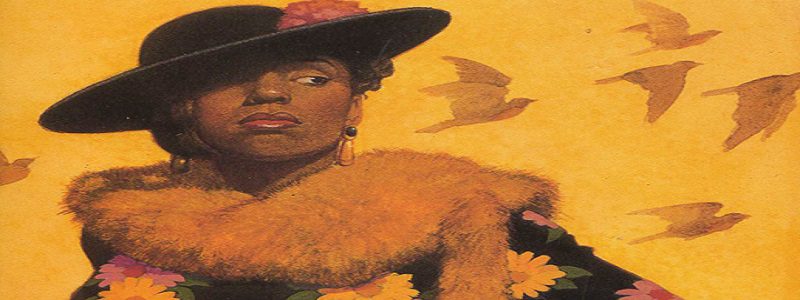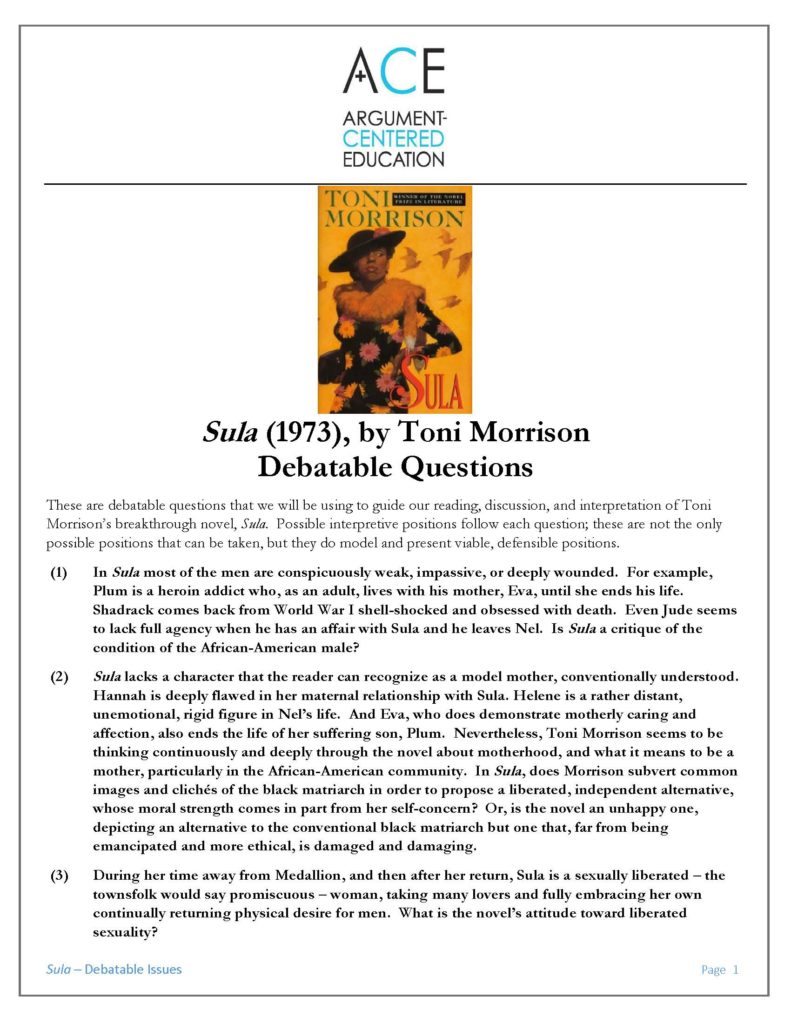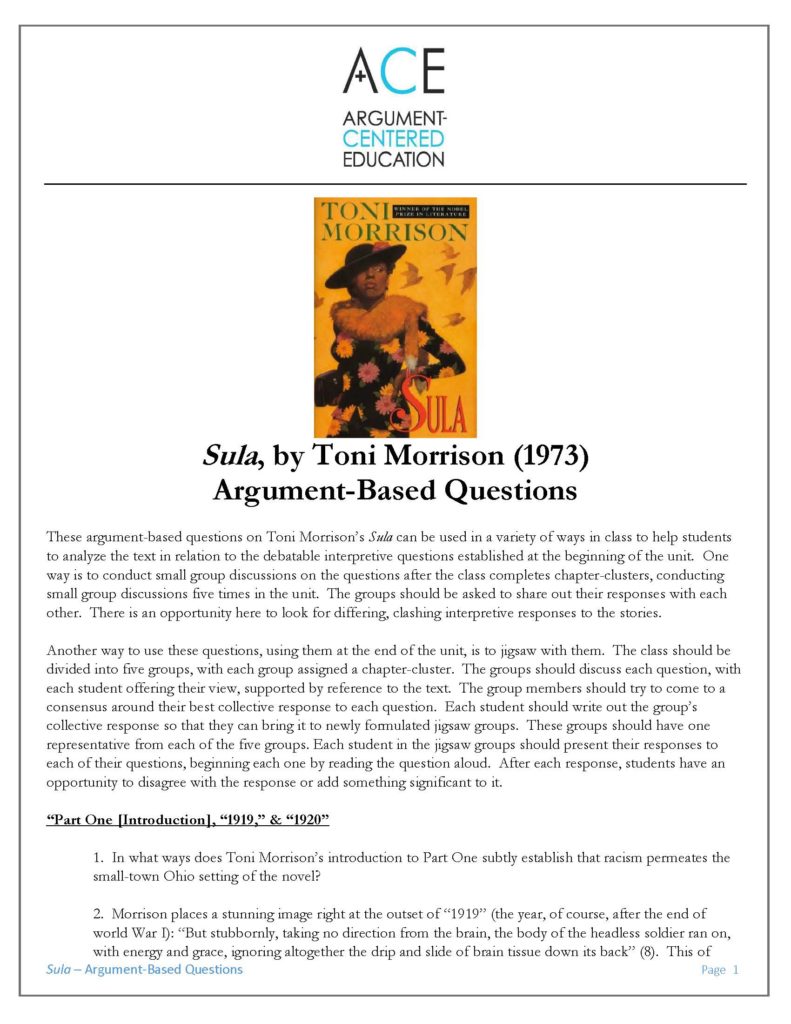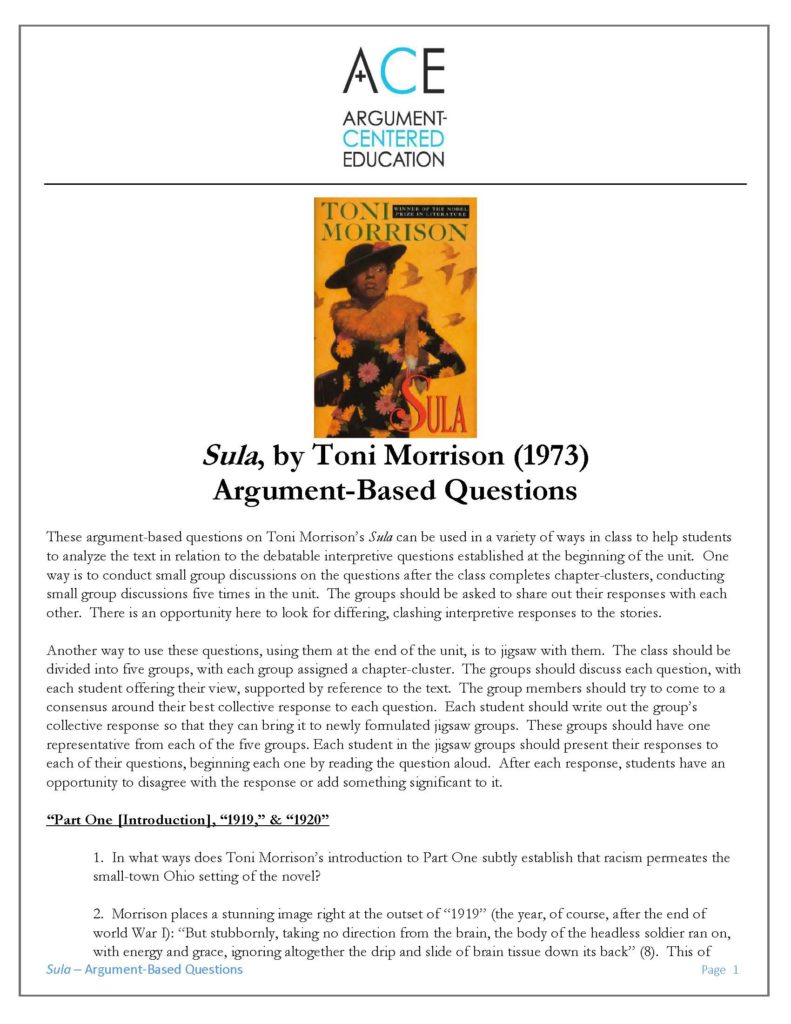
‘Sula’ and Sexuality
Nobel Prize winning writer Toni Morrison’s second novel, Sula, is relatively short (at about 180 pages) but challenging, as its style is a kind of uncompromising vernacular, and its characterization is stark, extreme, almost gothic, without a whole lot for teenage readers to warm up to. But the novel’s ambition is unmistakable. It is an august work and it rewards patience, readerly fortitude, and close study. Writing in the early 1970s (Sula was published in 1973), Morrison was committed to addressing questions rapidly fermenting in the culture involving gender, racial, socio-economic, sexual liberation, through a language and an imagery intrinsic to African-American culture that was demythologized and in some ways purified.
Looking back on her novel 30 years later, Morrison wrote:
My only option was fidelity to my own sensibility. . . . And since my sensibility was highly political and passionately aesthetic, it would unapologetically inform the work I did. . . . What is friendship between women when unmediated by men? What choices are available to black women outside their own society’s approval? What are the risks of individualism in a determinedly individualistic, yet racially uniform and socially static, community? Female freedom always means sexual freedom. . . . Hannah, Nel, Eva, Sula were points of a cross — each one a choice for characters bound by gender and race. . . . And the only possible triumph was that of the imagination. The job, of course, was summoning those perceptions in language that could express them. . . . To use folk language, vernacular in a manner neither exotic nor comic, neither minstrelized nor microscopically analyzed. I wanted to redirect, reinvent the political, cultural, and artistic judgments saved for African-American writers.
This past school year a partner high school was notably successful in inspiring and guiding its students to a college-level understanding and ultimately interpretation of the subtle but resonant ways that the novel develops its inquiry into these aspects of Morrison’s sensibility through her singularly “reinvented” “folk language.”
I worked with the lead teacher on the Sula unit to develop several debatable issues. We identified a question on the novel’s striking pattern of wounded or emasculated African-American men; on its apparent critique of an African-American matriarchal mythology; and on its attitude toward Sula’s liberated sexuality, echoing the “free love” revolution of the novel’s own historical era.

This unit is used with 11th and 12th graders in both African-American Literature and World Literature courses, students who are all or almost all college-bound and relatively sophisticated readers of literature already. Still, some sizable portion of the students struggled at first to formulate positions in response to these debatable questions that clash with each other. Students’ first instinct was often to avert the interpretive conflict at the heart of each of these three questions. They sought a quick compromise, a way to in effect neutralize the interpretive clash. So we felt that it was important to put forward model position (i.e., thesis) statements, modeling interpretive statements that make a commitment to a reading, that take up the challenge of weighing evidence and drawing and defending conclusions about readings that are better supported by the text than their alternatives. We developed these position statements and distributed them as exemplary options.

Students worked in groups through the novel’s chapters discussing and writing extended responses to a set of argument-based questions we developed. The questions are all aligned to the debatable questions, so that as students think critically about and develop arguments in response to the questions, they are working with evidence and making interpretive claims on the debatable issues that they will address in their summative assessment.

The unit’s argumentalized instruction was proceeding apace, with high levels of student engagement and a coherent, critical strategy organizing student work on the novel, when something intriguing and illustrative took place in these classrooms. Students and teacher found themselves discussing and writing about a question additional to those that we had established. Students and teacher were gravitating toward passages and interpretations that placed the lens on whether Sula develops a critique of heteronormativity and is a submerged celebration of female homosexuality.
At first, the teacher wasn’t sure that this could be added as a debatable issue to the unit. “It seems that the students who are most interested in this reading just say, this is what the novel is about, it’s not really an open question. They don’t seem to see it as ‘debatable.'” So she and I first got together ourselves on how to debatify this reading. What would a critic say who disagreed with an interpretation of Sula as a critique of heteronormativity and a veiled celebration of female homosexuality? Since the heart of the reading is that Sula and her very close friend Nel have an unacknowledged romantic relationship, a deep sexual attraction to each other, a counter-reading would have to insist on the importance of Nel and Sula’s friendship as a Platonic relationship, as a counter-weight and a protection from a “lesser desire” inherent to sexualized relationships. Plus, this counter-reading would read female desire for men in the book as liberating, not like men’s often subjugating desire for women. So we had our fourth debatable issue.
In Sula, romantic relationships between men and women are often devalued and delegitimized, sometimes represented as an imbalanced financial exchange in which women sacrifice their identities and needs for physical protection and the validation found in being needed. The love between childhood friends Nel and Sula is the most enduring and pure love in the novel, and is sometimes described with allusive sexual imagery. This suggests a fundamental interpretive question: Is Sula a disguised celebration of female homosexuality, or is it an assertion of the superiority of female platonic friendship over the exploitations inherent to heteronormative romantic relationships? Or, is its gendered theme some third (possibly hybrid) alternative?
We added this to the official set of debatable issues for the unit.

And we included several additional argument-based questions to align with this new question on female sexuality specifically.

The unit culminated in an argument-based seminar in which students brought together all of their interpretive arguments and readings of passages that they examined through the questions they worked on by chapter. Following the seminar, they wrote a final interpretive essay addressing the issue of their choice. No surprise: most students chose this partner-teacher’s own addition to our original set of debatable questions. And also no surprise: they wrote with an impressive college-level of analytic depth and critical thought.

